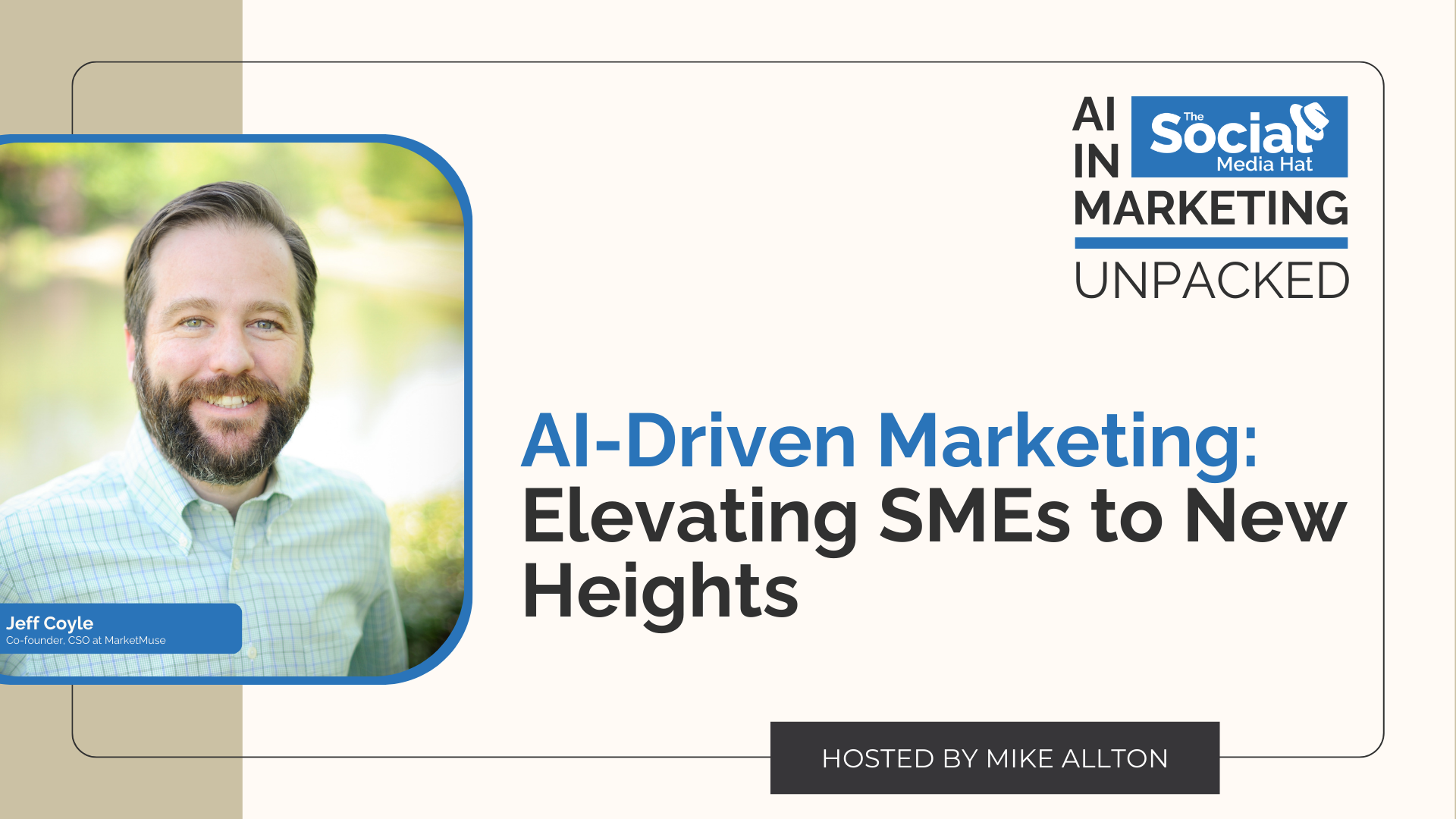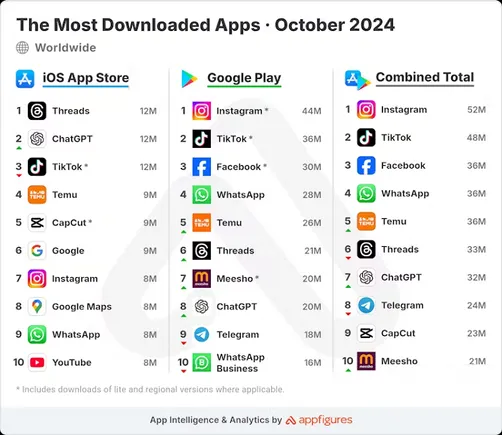Reading Time: 29 minutes
How can your business truly stand out in a crowded content landscape?
Are you maximizing the expertise of your subject matter experts (SMEs) to create high-impact content?
And most importantly, how can artificial intelligence take your SME-driven marketing to the next level?
LISTEN TO AI IN MARKETING: UNPACKED:
WATCH AI IN MARKETING: UNPACKED:
In today’s episode, we dive deep into these questions with Jeff Coyle, co-founder and Chief Strategy Officer at MarketMuse. With over a decade of experience in AI-driven content strategy, Jeff will share how integrating AI with SME expertise can revolutionize your marketing efforts. He’ll provide actionable insights on leveraging this powerful combination to drive better results and deeper engagement.
AI in Marketing: Unpacked host Mike Allton asked Jeff Coyle about:
✨ Integrating AI with SMEs: Learn how businesses can effectively combine AI technologies with SME expertise to enhance content marketing strategies.
✨ Practical Applications and Insights: Discover real-world examples and practical tips for leveraging AI to elevate the impact of SME-driven content.
✨ Future Trends in AI and SME Marketing: Gain insights into upcoming trends in AI-driven marketing and how businesses can prepare to harness these advancements.
Learn more about Jeff Coyle
Resources & Brands mentioned in this episode
Full Transcript
(lightly edited)
AI-Driven Marketing: Elevating SMEs to New Heights with Jeff Coyle
[00:00:00] Jeff Coyle: I’ll probably shock you when I say this, the least interesting thing that a large language model can do is to write a draft for a page of content I want to put on the web. To me, that’s not terribly interesting. And I know everybody’s like, what, what are you talking about? For me and for, you know, my peers and people who are thinking about this, the way that we do, it’s really great at doing things.
That get me closer to be able to execute on piece of expert content, not actually writing the, why there are so many reasons why you mentioned a few of them, but what I don’t want to put myself in a position of is where that my end result is a draft that I’ve generated, that I had to edit dramatically and maybe even decrease my efficiency.
And then what I get out of the bottom is something similar to what I would have written on my own.
[00:00:56] Mike Allton: Welcome to AI in marketing unpacked, where we simplify AI for impactful marketing. I’m your host, Mike Allton here to guide you through the world of artificial intelligence and its transformative impact on marketing strategies. Each episode, we’ll break down AI concepts into manageable insights and explore practical applications that can supercharge your marketing efforts.
Whether you’re an experienced marketer just starting to explore the potential of AI, this podcast will equip you with the knowledge and tools you need to succeed. So tune in and let’s unlock the power of AI together.
Greetings program. Welcome back to AI in marketing unpacked where I selfishly used this time to pick the brains of experts at keeping up with and integrating or layering artificial intelligence into social media, content, advertising, search, and other areas, additional marketing. Oh, and you get to learn to subscribe to be shown how to prepare yourself and your brand for this AI revolution and come out ahead.
How can your business truly stand out in a crowded content landscape? Are you maximizing the expertise of your subject matter experts, SMEs to create high impact content? And most importantly, how can artificial intelligence take your SME driven marketing to the next level? In today’s episode, we’re going to dive deep into these questions with Jeff Coyle, co founder and chief strategy officer at MarketMuse.
With over a decade of experience in AI driven content strategy, Jeff is going to share how integrating AI with SME expertise can revolutionize your marketing efforts. He’ll provide actual insights in leveraging this powerful combination to drive better results and deeper engagement. Hey Jeff, welcome to the show.
[00:02:32] Jeff Coyle: Hey Mike what a great intro. Can’t beat that. Thanks That’s what we’re going to do today. That’s what I’ve been doing since I’ve been trying to do it since the late nineties and now you know, sort of last decade, that’s what I’ve been living, that’s what I’ve been living.
[00:02:43] Mike Allton: Love it because that’s what I always like to say.
It’s, it’s not me talking about you. It’s the work that you’ve done that allows me to say amazing things like you’ve been doing this for a decade. And in full transparency, a lot of this is AI helping me come up with these crafted intros, but. I’d love it if you could start by just sharing a bit about your background because I don’t want to just touched on it briefly and how you became involved in what we were calling AI driven marketing.
[00:03:09] Jeff Coyle: Sure. So I went to, I went to Georgia Tech for computer science. I’m originally from Jersey, moved down to there. And while I was there, I was doing, I was focused on two things. One was the earliest versions of search engines. So intranet search, if People even know what an intranet is and then, you know, more like, like enterprise search, basic texts, retrieval, and then also usability and, and user interface software and accessibility and those types of things.
So some of the early work I was doing was, I mean, it sounds pretty nerdy, but you know, taxonomies and ontology is then classifying things into things, right? This was before auto tagging. This was before there was really strong linguistics tech. And then I, I. My junior year in college, I started working at a startup called KnowledgeStorm.
I was one of the first employees first interns there and then worked there till it was acquired in 2007. What we were doing, we were trying to sell B2B tech companies to have content on their websites. Big companies, IBM, Dell, they didn’t have any of their content on their website. So we were like, get that stuff on the web as crazy as it sounds.
And we were generating leads. At one point we were generating millions of leads per month with this network of hundreds of sites that we had basically a white paper directory. And then we were acquired by tech target, who you may be familiar with, where I ran their traffic search and engagement team.
So all inbound. Paid social community management. And we were generating leads, but we were also developing amazing content. A tech target was across a network of over 200 websites. And that was my experience of going from thinking only about leads and only about performance to having an editorial team and writers.
Who were subject matter experts. And I walked in the door thinking I knew everything about everything, frankly. And I said, here’s what you should write about. And you know what happens when you say that to an editor in chief who knows their stuff and has 20 years experience. They’re like, Nope, not doing that.
So I had to, over the course of years, figure out. And begin, you know, join the journey of respect, frankly, for the subject matter expert and the editorial excellence that was on that staff. And I didn’t at first, I was like, just write this article and it’s going to rank and we’re going to get a lot of traffic and get a lot of leads.
So that kind of merging of and that clashing in many cases, because we were all fighting for. You know, scarce resources and the scarce resource of a writer is tough. And so I had learned every workflow, all these horrible manual editorial workflows, and they, they, they were like keeping me up at night every day.
Right. And so when I was when I left tech target and by the way, we were very successful. And the editor editorial teams you know, that started to consider performance marketing crushed it. I mean, they are superstars of kind of performance marketing melded with editorial and SEO team.
They’re amazing to this search engine optimization team. And then when I was working in a private equity firm and doing some side work and I met my co founder of of MarketMuse. And I originally thought that the technology was something that you would use to classify. I love classifying things in taxonomies to classifying content into categories.
And I asked him, I asked him over email. I said, Hey Aki does this software classify documents into categories? Because that’s what I’m excited about auto tagging. And he’s like, no, but here’s what it does do. And what it did was examined topics and concepts and content to see if it exhibited signals of expertise.
And my brain exploded. I’m like, oh, my gosh. And by the way, this was 10 years ago. This was a I tech that, you know, the earliest versions of natural language understanding and topic modeling and graph analysis and vector analysis. And it was a very clever approach to doing something. I didn’t. Feel like was going to ever be solved.
And so that was when market muse was born. And so what we do is we’re able to analyze content and state whether it has the signals that an expert has written it. And then we take that at the site level. We expanded that to build briefs to support writers. And then we expanded that to do site level analysis.
So we can actually look at your site and group it into clusters and tell you where you have strong ones, weak ones. Hey, you want to own this topic, Mike? Well, you got a lot of work to do, or this one’s gonna be an easy lift. And what that does is it puts the editorial excellence and subject matter expert in the driver’s seat.
So that they’re not necessarily going to only have to do one type of content. They can actually say we’re going to win through editorial excellence. And that frees, frees up both teams to do great work. And that’s something that I’m very passionate about. It’s editorial performance, marketing search, all being on the same page.
[00:07:58] Mike Allton: First of all, you know, intranet took me way back to the 90s. I used to work for Dana Corporation. We had a Lotus database and Lotus nodes. And yeah, I was, I was, you know, neck deep in intranets back there. Cause I was part of the global IT. You know, Dana was an 80, 000, you know, global employees kind of a company.
So the intranet was a big deal
[00:08:22] Jeff Coyle: there.
[00:08:22] Mike Allton: Enterprise
[00:08:24] Jeff Coyle: search still isn’t perfectly solved. I mean, now with agents, AI agents and you know, is there more we can do with AI with, with internal search? I think it’s a, a, a way to, I think that post sale documents as they call it, which would be internal documentation, technical documentation are often.
Unknown to the org. And so through through enterprise search and through, um, clever AI techniques and, you know, a couple of things like that. It’s still an untapped. Open opportunity for people to, for excellence, I believe, but because of there’s a big gap between the post sale docs owners and the marketing people still, and so I’m not dealing with that one right now, but I’m dealing with the content marketing gap with editorial and SEO, basically.
[00:09:16] Mike Allton: Yeah, I totally agree. There’s a, there’s another podcast I listened to the AI edge and they’re focused on enterprise level implementation of AI. And that’s something they talk about a lot because the data is just so distributed. It’s not in any cohesive way. It’s not standardized. And, and that’s the biggest challenge I think today with, with AI implementation, what data are you giving the AI, but I’d love if you could just Take a minute to share a little bit more about, about market muse.
I’m wondering if you can break it down for the audience, because we’ve got markers of all stripes that listen to the show, you know, we’ve got social media marketers and so on help them understand how they or someone else in their organization, you know, would, would use market muse.
[00:09:56] Jeff Coyle: So I’d like to think of like three stages of content strategy.
So if you want to go deeper, it can be something like ideation you know, ideation. So what should I be doing? Doing data analysis? Research, briefing, writing, editing, publishing, post publish optimization, right? That’s like the deeper dive, but I like to break it into basically analysis. Planning and execution.
And what MarketMuse we’re focused on all of the above. So giving you a way to use artificial intelligence that’s personalized for your site or your network. So the 1 unique thing that we can do is we look at your site and look at your existing coverage. Of content. Look at your breadth of coverage on a topic, your depth of coverage, the quality of that content with respect to expertise, right?
Then also performance. Is it working? Is it doing well, right? And when you combine those things, I can give you personalized metrics for how much work you need to do. to level that up. And so that analysis can happen in three or four different ways, right? It can be through cluster analysis, which people are afraid of.
But all that is is I’m looking at your site and I’m reading your content and I’m bucketing each of those pages into groups and then saying, Hey, this is a cluster. What are the areas of this cluster you haven’t covered? Right? So a cluster on on demand cluster gap analysis. Now, the next Frontier for marketers is intent.
Does my content appeal to the target intents? So we have the ability to analyze what are the target personas, what are the target intents and deliver recommendations. The third would be quality content quality. So where do I have buckets of content? That are thin. Where did I try to, you know, cause five years ago it was easy.
I was just popping up a bunch of listicles on my site. Right. I made a bunch of money right now. Not so much. So I can basically say, yeah, you could still own this topic. You need the early stage awareness. You need the middle of the funnel. You need better listicles because those kind of strength, and then you need that post purchase troubleshooting.
You need the ownership content, which is. By the way, if you’re, if you’re selling products, that’s one of your secrets today is troubleshooting and ownership. What are the articles that you’re writing after you buy those pairs of shoes? That’s, that’s the stuff that a lot of these sites are missing. In case you want a hot tip check your site, look at your favorite topics that have declined.
If you were only writing about middle of the funnel, you need early stage and you need post purchase. That’s your, you know, million dollar takeaway for today. And then, so, so we look at that and we, and we’re able to say, Hey, here’s what you are to do, or you may come to us. So that’s, if you don’t know what to do, we’ll prioritize what to do.
That’s that, that analysis and research. Now you get into planning. Okay. You told me I need to write an article about. You know podcast microphones. What, what is it? What do I do? I don’t know. Is it, am I just writing a, what is a podcast microphone? That seems lame. Well, so now that’s planning, right? So based on what I already have, what do I need to do?
Do I need to update some pages? How many articles do I need to build? And in what target markets and groups do those live? That’s the next phase. Then I can say, Ooh, I like those. I want to do those. Let’s build briefs for the ones I want to build. Right? So then I can build those briefs. Now, my writer can go execute that any way they wish, right?
Use your favorite A. I. Assistant. We have one if you’d like to use that. Ours is cool because it keeps the topic models and the graph analysis in context. So, if you want, you know, if you want to use those or use whatever, but we give you the ability to analyze that draft and say whether it has met expectations of the brief and then publish confidently.
Not just public confidently, like this is good, but published confidently knowing that you’re basically playing money ball with content, right? I know these are the four articles you needed to write. So when you publish it, you’re like, it’s not just a black box. What we do is we take teams and I gave the detailed explanation.
We take teams from hitting one out of 10 batting average of content. I write 10 articles to get one to perform well up to 30, 40, 50. And above percentage and that changes everything for editorial that changes everything for the writers because they’re like, I know, I believe I can win. I mean, I, I speak into, I spoke to a writer where they were a member of the team.
They didn’t get to decide what they wrote. There was an editor and this was recently, and he was frankly like downtrodden. It was just like, he’s like, nothing works. SEO is broken. And I’m like, it’s not. And I show him a few of my number ones and rank brag hashtag rank brag. And I’m like, dude, you will be able to get there.
He’s like, it’s, you’re just not picking the right, you know, horse to bet on is now I’m seeing that writer crush it. And this was in entertainment and travel. And one of the examples I always give, I can’t say the name, but but the he, he was like, do I really have to write 26 articles about this celebrity?
And I’m like, yup. I’m You do sorry, but you do. And he’s like, Oh man, that’s brutal. And I said, just trust, just trust me. And guess what? They were there when the, when the next news cycle hit and this particular celebrity was involved, they owned it. And guess what? He gets paid on page views. So
legit money ball. So that’s kind of the, that’s kind of the play, right? It’s what should I do? Back it up with data so we can all get along. This isn’t just a. You know, hitting hope. Give me more details. Make sure I can personalize it and we’re going to get it. We can get into that because that’s a big gap is how to personalize outputs of artificial intelligence.
I’ll make sure I can personalize it. So I feel good about what I’m writing. I’m not just publishing crap. And then, you know, support me as I execute and then you can even go back a month later and we’ll give you advice of how to make the page better after maybe the intent shifted. Maybe the world changed, right?
You go back to that page and say, how should I refresh this for today’s intent? And that’s really great for news events, local which are all target markets for us.
[00:16:24] Mike Allton: I mean, this is, this is the power of ai. In fact, we did an entire episode with Andy, Christina, all about content gaps and how to identify ’em and fill them in.
I’ll link to that in the show notes for you guys and one of my favorite partners and market Muse,
[00:16:37] Jeff Coyle: market Muse customer for many years, by the way. So if you want to do stuff like Andy and his team, by the way, he’s got a lot of times it’s Andy. He’s got a killer team. I mean, they are orbit. If you need an agency and I’m like, plug in, plug in Andy.
Oh yeah. Orbit’s got their, Orbit’s got their act together. If you have a WordPress site, Orbit’s got their act together.
[00:16:57] Mike Allton: They are amazing. He’s a genius. It was a terrific episode, but we want to talk about SMEs and content marketing. And I’m really interested in your opinion on how that’s evolved, how that role has evolved with, with all this AI.
Well,
[00:17:14] Jeff Coyle: What I’ll say is, Evolved? Yes. The Sharps the Sharp, the Sharp players, this has been part of their playbook. Now it’s easier to be part of your playbook. And what I’ll highlight is, I think you can speak to this through the evolution of content agencies. It is, there was a lot of low quality content agencies that existed.
Right. But there were a few that got that they needed to be subject matter. They needed subject matter experts in the loop. All right. How did they do that? 1 group would say we’re going to go find experts. They’re on our staff. There are contract killers. There are mercenaries. And they’re going to support you other content agencies that focus on expertise would say we’re going to extract the great goo out of the heads of your employees.
Right? And the people that, you know, we know that, you know, that, you know, that are part of that ecosystem. Some, the smart and the sharps, I think on the agency side had both. You could actually do one or the other, but that makes content more expensive. Yeah. And then the world exploded right now, there’s an infinite supply of low quality content.
There’s an infinite supply of like mediocre content that is uninspired. That change makes subject matter experts the most important person in the room. So if you are a product manager and you know everything about your product, you are the most important person in the room. If you’re an executive and you know the space, You are the most important person.
If you’re the person that manages technical documentation, post sale documentation, you’re CX people. So people have been saying that for a long time. Like these are people are important. Let’s get this stuff out of, but it’s been so hard. What do you do? How do you get them to write was always the challenge.
What if you’re in a law firm? Do you really get your best lawyers to spend their time writing content marketing? No, that doesn’t work. It doesn’t work in practice. It’d be great. They did. First of all, they not journalists. They are not good at extracting information from their own brains for this purpose.
And so what it does is it makes the subject matter expert and the journalist and the good researcher, the two cogs that make this machine work. And then the technology that has advanced that accelerates this is a language model and data based analysis. So I can take transcripts. And do a lot more with them a lot quicker.
I can take audio recordings and do a lot more with them a lot quicker. I can take a suitable for analysis. Conference call right with people on it and start a conversation and see where it goes and I can do a lot more with that than I could in the past. That’s what starts to unlock this. So when we get into kind of some of the ways to actionable insights, it’s a lot about you becoming a real journalist.
If you’re not already, Okay. Instead of a keyword researcher and not that I’m knocking keyword research. That’s that’s my stuff. I’ve been doing it for a real long time. But it makes you have to become a great journalist overnight. Makes you have to learn how fact checking works. Makes you have to learn how research can be effective and efficient.
And then how to weave that together with your performance and, you know, other types of needs, brand, style, voice, tone, right? If you were just writing, you know, garbage for the blog to try to get rankings, that horse left the station a whole long time because you are a dollar a dozen. There’s a whole lot of SEOs that can do that.
You can’t do that anymore. You can’t just write media content for the blog, get your four pieces out a week, call it a day. It doesn’t work anymore. You have to change. Yeah. I’ve been saying this for multiple years on top of the soap box. Now it’s reality. Everybody’s like, Oh man, I literally had a slide. It said, you have to change today.
So I was like, man, Jeff, your presentation was a little doom and gloom. This was a couple of years ago. And I’m like, it’s coming, dude, it’s coming. And I said, you gotta get ahead of this. And to now the people who had the expertise, who had full funnel coverage, instead of just maybe middle funnel or bottom of funnel, when they’re trying to just get leads those are the winners they’re winning right now.
sand and change. You’re going to go up and you’re going to fix this and you’re going to get experts in the loop and you’re not going to build a generic brief. You’re going to build a brief with the inputs from your business so that when your writer or your product manager reads the brief, they’re like, Ooh, wow, this is cool.
This is actually personalized. I want to help out with this project. They don’t just look at it and it’s hard to tie shoes. How to tie a shoe or how to boil an egg, that type of content which for a long time has been the norm for content marketers, not embracing artificial intelligence.
[00:22:08] Mike Allton: Completely agree folks.
We’re talking with Jeff Coe about creating content using AI, particularly as an SME and how that’s changing dramatically. And I’ve got a few more questions for him, but before I get to those, let me share with you the tool that I’m using as an AI assistant all day long. This episode of AI and marketing unpacked is brought to you by Magai, your gateway to making generative AI, incredibly simple.
Wondering how to seamlessly integrate AI into your marketing strategy without getting bogged down by complexities? That’s exactly where Magai shines. It provides user friendly AI solutions that empower marketers just like you to innovate and elevate your campaigns without needing a degree in science.
Imagine having the power to generate creative content, insightful marketing data analysis, or even personalized customer communications all at the touch of a button. Magai isn’t just about providing tools. It’s about Transforming your approach to marketing with AI that’s tailor made to be straightforward and effective.
So, whether you’re looking to boost your content creation process, or want deeper insights into your marketing performance, Magai makes it all possible with a few clicks. No fuss, no hassle, just results. Ready to simplify your AI journey? Visit Magai today to learn how their solutions can revolutionize the way you engage with your content.
With your audience, don’t just market, market smarter with Magai. Tap the link in the show notes. So Jeff, you actually touched on some of the challenges, right? Where it’s too easy to use AI to create mediocre content. It’s too easy to ignore that AI might generate Quote unquote facts that aren’t actually facts.
It’s hallucinating. You know, I’ve, I use AI obviously to help me with this podcast and I have to specifically tell it when it’s trying to get quotes. A don’t give a quote from me and B make sure it’s a quote from the guest that is literally from the transcript. Don’t make it up. I have to tell it that.
So we’ve got these challenges. Can you give us a use case or an example or a case study where AI, despite all these challenges, still significantly positively impacted some SME driven content.
[00:24:15] Jeff Coyle: Oh, yeah. Gosh, I could pile it on with a, with it, but I, I, you’re your, your your mid real discussion. I wanna try Magai now.
I don’t, I never tried that. It’s awesome. Yeah. I’m, I’m ready. I’m, I’m gonna, right after that, my, the first thing I do so involving SMEs, right? So the.
It when you, when you graduate, I’ll say from a standard large language model interaction, you can start to think of this thing’s really good at a lot of stuff. And I’ll, I’ll, I’ll probably shock you when I say this, the least interesting thing that a large language model can do is to write a draft for a page of content that I want to put on the web.
To me, that’s not terribly interesting. And I know everybody’s like, what, what are you talking about? For me. And for, you know, my peers and people who are thinking about this the way that I do, it’s really great at doing things that get me closer to be able to execute on a piece of expert content, not actually writing the expert content.
Why? There’s so many reasons why. You mentioned a few of them. But what I don’t want to put myself in a position of is where that my end result is a draft that I’ve generated that I had to edit dramatically and maybe even decrease my efficiency. And then what I get out of the bottom is something similar to what I would have written on my own.
So, what I don’t want to do, let me just make this clear is spend time only as an editor and then. Not improve speed and not improve quality. What I want to do is I want to bring all of my amazingness to the table during the planning phase so that right before the draft gets written, the thing that if, if you’re going to feed it in the habit, Draft copy is all my stuff.
It’s all of my magic. It’s my unique experience. It’s my unique expertise or my teams. It’s my expertise of my CEO or of my product management lead or of my CX person. It’s not that I’m going back to my draft and I’m adding the anecdote from CX from customer success. I want that in the loop because that actually melds together a great story.
Them being involved. So how can I bring the heat there? Microsoft I want all of that involved in my process. Some people can, and so if you’re not familiar with what an agent is, basically you can you know, like you’ve seen with chatbots, what is the data set that it’s able to reference, right? And that’d be a unique thing.
So is that your website? Is that, you know, a particular set of materials, those 1 way that you can start to get more refined. You can also have those tomes or those documents on your end. That are cycling through the process. So you’re making sure that your brand style tone voice are in the loop before the process begins.
I feel, and I’m, you know, my, I take things a little bit different. I’m most efficient to just get to the line of that perfect briefing. And then I’m able to execute and write very fast. I’m extraordinarily slow. I’m not a great writer at all. And so that’s the way that I. Speed up my workflow is to have that perfect artifact right before the writing begins.
What is really great at is distilling, summarizing, establishing a great process that you might have blind spots on turning one type of content into another. So, how do you use that? You asked for a couple of examples. 1 of my favorite examples is a team who has. has worked with us to envelop these technologies, they pick winners.
All the time they operate at 50 percent plus for performance. What is their goal to publishing? Which most people can’t dream of 10 percent about the industry average that we see. So you’re writing 10 articles to get one to work. And one of the coolest things that I’ve seen isn’t even what MarketMuse does right now.
It takes that the, the final, the copy that gets approved integrates it with the brief and builds. Many different campaigns out of it for other omni channel for other channels. So they know their source of truth is. The brief is the content that gets approved, and then they use that to turn it into a social media campaign to turn it into an email marketing drip campaign to turn it into a internal education campaign to turn it into a customer training campaign.
And that to me is magic. You did one unit of work that you’re super proud of. When it hits that, you know, they use the term of bullets and cannonballs when you have a cannonball that, that opens up the, it allows that page to then become seven different campaigns. That’s the ultimate repurposing. And you can do that extraordinary quickly and extraordinarily.
Efficiently and in high quality. As long as you have those artifacts to start with. If you don’t, you just take a page, maybe your competitor’s page that I’ve seen people do don’t do that by the way. And you try to turn that into your own social media campaign. It’s not going to really work out, but those are the ways that the winners keep winning.
When you can turn one unit of work into eight with no risk, think about it. Right? Cause when you’re doing this just for on page content, if you do anything less than amazing. You’re putting your site at risk search engine optimization perspective when it goes omni channel when you turn that amazing content into all these other things, those aren’t risking those aren’t putting you at risk.
So the, the, the sharps right now are doing an amazing job with their web content and they’re seeing how can they repurpose most effectively for distribution. And that is a way to get 7, 8, 9, 10. X on your returns. But I’ll also say is as an adjunct, there is a lot of times those other channels are under fire because they’re not being connected to revenue.
So people are looking for ways to streamline. You’re not trying to eliminate those things, but you’re trying to eliminate manual work when you can’t connect it to revenue. And if you have any channels that you’re not reporting against revenue, this is your step. This is the way you change the way that everybody in your company thinks about marketing.
[00:30:53] Mike Allton: That’s something we talk about a lot at Agorapulse, you know, I work full time there, we’re a social management tool. And you know, one of the key tenants is we’re connecting the individual links that are shared to social media through Agorapulse, whether that’s a post or reply or direct message. We’re tracking all that we’re connecting to Google Analytics.
So if you’re sharing a blog post in a direct message to somebody who expressed some interest, maybe it’s a sales outreach, we can track that specific link, click, pull in Google Analytics data and know, did that person end up signing up for a trial or a demo? So what’s their actual revenue? So now all of a sudden we get actual revenue reporting from social media.
And I can participate in that process by helping us identify the best piece of content to share the best snippets and that sort of thing out of those pieces of content to share. In fact, we’re probably building an internal L. M. And a model that will help our sales team understand if I’m in this conversation with this prospect who has this specific pain point out of the 1000 pieces of content that we’ve created in our existence, probably more than 1000, right?
Yes. Yes. Can I share with them right now? I’m leading a squad right now where I’m being asked to train sales reps on the best pieces of content that we have. And I’m going to do that. But at the same time, I’m thinking this isn’t scalable, right? How do I keep training them on all the content that’s out there?
I’m not going to. I need to give them a tool that they’ll be able to have in their hands to search all that.
[00:32:23] Jeff Coyle: Yes. Oh, man. So. There, I can unpack that. Okay. So I’ll just take it back. Right. So someone who I feel is like the best sales enablement expert, her name’s Pam Didner, or if you’re not familiar with her, she’s fantastic.
Oh, Pam, great, great friend of mine. Super thought leader in sales enabled, wrote the book on sales enablement, if you, if you care about one of the things she always used to say is I can always, I can tell your gap in, and you, if you know, Pam, you can tell your gap does your, do the stages in your CRM match?
The buyer journey that your marketing team markets against and then everybody, Oh, no, it’s like, it’s like a demo, you know, okay. Is that what your marketer marketing team focuses on? Okay. The merging of those two things is in my opinion, the easiest definition of sales enablement. Well, now with the ability to analyze calls, potentially have an agent live with you on the call and have access to your entire library for recommendations.
The first is semantic similarity. I know it’s a nerdy way to say this is the article you have that matches the collective of the text or the vectorization of the text by the way, vectors 3D cube of all the concepts related to the thing you’re talking about. Imagine that. So there’s, if you’re 6 degrees of Kevin Bacon, 6 degrees separation, right?
I’m talking about Nike shoes something over here in left field inside that 3D cube mentions hiking. Running, right? So that’s just, that’s kind of something to think about some way to think about it, right? If you were to write about hiking shoes, and you never mentioned the concept of trails or trails trail running, you’re probably not an expert.
That’s your that’s kind of the way that vectorization works easy way to think about topic modeling. So you can do it solely with that, right? So, oh, these people are talking, I’m on a phone call podcast microphones. I better mention my experience with Blue, or a review I did from six weeks ago about the Yeti Yeti microphones.
Okay, so, but the next frontier on that is feeding in your success data from your CRM to train that model. All right, so I could take when this article was shared, when this page was shared, did it progress the deal, how much revenue was generated now feed that back in to the top of that learning system.
Now, not only am I giving my salesperson. I think we’re just inventing a product right now. Not only do we give my yeah. Okay. You can have the trademark. So not only is, not only are you feeding in this, so you’re basically giving the, maybe you give the rep the most relevant document, but then you give them the one that likely will win the deal.
Ooh, that’s hot. Right. And so with basic data studios, there’s actually a data studio called Mad Kudu. M A D K U D U. You could achieve these things today in short order. So yeah, these are the types of things I think about and dream about. It’s get the right, get the right content to the right people at the right time.
A lot of these publishers are doing this too. Just to tell you the truth, they’re thinking about this too. So you’re going to see a lot of new things from publishers who are advancing. And driving the bus. If you’re not already planning on it for, especially for the audience, M A I C O N Macon, it’s in Cleveland.
Do you want to hobnob with everybody thinking about this and buy me a beer? I’ll go to that. And and and we’ll you, you want to see the, the kind of the next frontier here is it’s people who were thinking like you are and people who are thinking about, Hey, I could. Just give them an internal search engine, right?
For my docs or actually could connect this to revenue. I’m just going to have to invest. I mean, it’s going to cost me money. It’s time energy. I’m gonna have to get. You know, some belief from the executive team that this is worth it. Trust me though. I’ve done this. I’ve done this with predictive leads for done it with predictive lead scoring, same concept, and it’s a home run home run.
It’ll change the way you think about AI. Isn’t it funny how little we actually talk about generating content. Let me talk about this. My hottest tip for everyone. Think less about that and more about everything else. And guess what? Your content is going to get better and more amazing and more performance.
The, the siren song of pressing a button and getting a page is killing people, it’s killing people because what’s, what’s it doing? It’s making the C staff, the C level executives think marketing is not worth it. It’s making it them think it’s free and it’s making them think that content doesn’t have any value.
All right. It’s making lazy marketers publish higher volumes of mediocre at mediocrity. You gotta be the don’t, you have to be the don’t. On that craps table. Sorry. Sorry, folks, we ain’t doing this. We’re doing it differently. Right. So, yeah.
[00:37:46] Mike Allton: Yeah. First of all, yeah. Great shout out to MAICON. I went last year.
I couldn’t fit in my schedule this year. Definitely going next year. It’s a fabulous conference. In fact, last year it was with Agorapulse which was fine. They said I was stuck in the booth, so I didn’t get to go to any of the sessions. So I’m going to be fixing that next year. But it was terrific just to be in that environment and see all these folks.
Crazy who are largely in the same position we are, where they’re asking questions. They have ideas, but they don’t have answers. None of us do. Nobody’s an expert. Anyone says they’ve been an expert in generative AI for two decades. They’re lying. They’re lying. Been around that. I’ve been doing it
[00:38:21] Jeff Coyle: for, I’m doing, I’m doing about eight or nine.
So I, but it’s I always say, so we, we launched a generative AI product between GPT two and three. It was not a success because it was great. It produced amazing content, by the way. The best of its time, but to generate a page, it would take days and it would cost lots of money and no one wanted to wait five days to get five paragraphs content that costs 80 bucks worth of compute time.
Now that same thing is fractions of fractions of fractions of pennies. But. You know, having that experience of going through that made it so that I could build what I’m building right now. And it’s, I mean, shocks me every day. I mean, I’m generating, like I have a news brief offering, which comes out next month.
And no one’s doing that. And he like, like, when I see it, I’m like, this is cool. Nobody figured this out yet. So there is still frontiers that people haven’t figured out. And some of them are real hard to figure out. I I, I, you know, this, these are good for party games too. You know, I’ll bring, I’ll bring a, I’ll bring a brief for a restaurant review before my friends and I will go out to dinner.
I’m like, here’s, here’s our, here’s our review. And they’re like, you’re such a weirdo. Come
[00:39:40] Mike Allton: on. But the cool thing is a lot of the things that we are talking about today are doable. Right. You kind of talked about how they want the use case I was presenting was, you know, a quote unquote search engine of all the content.
But it goes beyond a quote unquote search engine because it’s, it’s smart. It’s if this product that we’re going to build is feeding in the data, right. It, it, it gets smarter. So in my business at Agorapulse, we’re often talking to folks who are currently using, let’s say sprout social. So an initial database might say, Oh, Give them this document that talks about how to switch from Agorapulse to or from from Sprout Social to Agora Pulse, which, okay, that’s all right.
Sure. But after some trial and error, you might realize, hey, this story of a specific company that looks just like them, how they switched and succeeded, oh, that’s gonna perform so much better. It’s layering in the context. It’s fantastic package. I love the, you just package this
[00:40:40] Jeff Coyle: up and send it to a bunch of VCs.
I think we just, I think we just raised a seed round with this, with this one . It’s not just right. It’s every thing where that type of process exists. If you want to get into explicit. Actional same thing, internal links, same thing. Internal links, right? Same thing. Content updates. I’m using a tool for internal links called link whisper.
Oh, I know, I know the founder very well. And Spencer Hoss, he’s a very close friend of mine and we have an internal link tool as well. So we We jab, we jab with each other. But yeah, Spencer and I are, are, are longtime close friends. So
[00:41:23] Mike Allton: yeah, yeah. It’s not to the level of what you’re talking about, right.
Where it’s, it’s analyzing success rates and giving feedback, but it’s, it’s smart and it’s fast and I love that. Wow. Okay. We we’re going to come back. You said we would be like,
[00:41:40] Jeff Coyle: we could make this six hours. I think folks, I
[00:41:42] Mike Allton: think I asked Jeff one question and obviously I just, you just spin them up and he takes off, which is fantastic.
That’s right, Jeff. You have been amazing for folks who do want to learn more, follow you, connect with you, where can they go?
[00:41:54] Jeff Coyle: I answer everything DM me on, on the X, Twitter, Jeffrey underscore coil LinkedIn. I just make sure you, you know, so you, so I don’t think you’re a spammer. Just mentioned Mike and mentioned the show.
If you, if you do shoot me a note on LinkedIn or you can email me, Jeff at market muse. com. If it was safe, I would give you my cell phone. I love this stuff. If you have a unique challenge with content or you just want to check out market muse, go to market muse. com. We have a reverse trial, so you get seven days of one of our premium packages at no cost, there is no obligation.
Go check it out. We have some new products coming in the next few. Weeks that are going to break your brain frankly. So depending on when you’re listening to this, it is June 28th when we’re recording it. But yeah, go check it out. And if you want more. Information about it. Email me or shoot the support a note.
And they’ll get you hooked up with the right people. But yeah, market news. M. A. R. K. E. T. M. U. S. E. I’m also I own a beer brewery based in Georgia. So if you’re based in Georgia, go check out silver bluff brewing. We have won a world beer cup U. S. Open. Brewski beer of the year. We are legit and one of the fastest growing breweries in Georgia.
So check that out.
[00:43:05] Mike Allton: Fantastic. We will have all the links in the show notes, but I’m afraid you’re going to have to go to Atlanta. If you want a beer, I can’t give you that digitally. And I think we should do that. Folks. This has been terrific. Thanks so much, Jeff. Thanks for all of you who’ve listening.
That’s all we’ve got for today. Don’t forget to find the AI marketing unpacked podcast on Apple and drop us a review. We’d love to know what you think until next time. Welcome. Thanks for joining us on AI and Marketing Unpacked. I hope today’s episode has inspired you and given you actionable insights to integrate AI into your marketing strategies.
If you enjoyed the show, please subscribe on your favorite podcast platform and consider leaving a review. We’d love to hear your thoughts and answer any questions you might have. Don’t forget to join us next time as we continue to simplify AI and help you make a real impact in your marketing efforts.
Until then keep innovating and see just how far AI can take your marketing. Thank you for listening and have a fantastic day.

Related
Discover more from The Social Media Hat
Subscribe to get the latest posts sent to your email.










